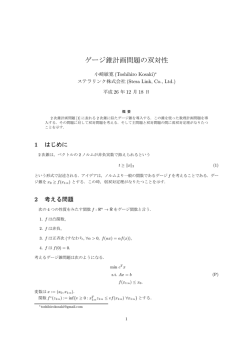
Multi-stage genetic programming
医療情報システム研究室 データマイニング班 【文献調査】 Multi-stage genetic programming: A new strategy to nonlinear system modeling 白石 駿英 廣安 知之 山本 詩子 2014 年 09 月 30 日 タイトル 1 マルチ段階遺伝的プログラミング: 非線形系モデリングへの新しい戦略 著者 2 Amir Hossein Gandomi, Amir Hossein Alavi 出典 3 Information Sciences, Volume 181, Issue 23, 1 December 2011, Pages 5227-5239 アブストラクト 4 この論文は非線形系のモデル化のために新しいマルチ段階遺伝的プログラミング (MSGP) 戦略を示す.提案さ れた戦略は,より正確なシミュレーションを提供するために説明変数の個々の影響およびそれらの中の相互作用を 組込むことに基づいている.MSGP 戦略によれば,問題のための効率的な公式化は異なるタームを含んでいると 考えられる.MSGP ベースの分析の初期では,出力変数は影響を及ぼす変数から公式化されます.その後,実際 のものの間のエラーおよび予測値は新しい変数から公式化される.最後に相互作用タームは,個々に高度に発展し たタームまでに予言された実際の値と値の間の差の公式化により引き出されます.MSGP の能力は,異なる複雑 なエンジニアリング問題の公式化にそれを適用することにより説明される.ここに分析された問題は下記を含ん でいる: (i)pH 中和過程のシミュレーション,(ii) 終了製粉業での表面の粗さの予測および (iii) 土壌液状化条件の 分類である.提案された戦略の有効性は,分析に含まれていなかった実験結果の部分に派生模型を適用することに より確認される.さらに,モデルの外部確認は他の研究者に勧められたいくつかの統計的規準を使用して確認され る.MSGP ベースの解決策は,調査されたシステムの非線形の振る舞いを有効にシミュレートすることができる. MSGP のその結果は,標準 GP および人工ニューラルネットワーク・ベースのモデルのものより正確となった. キーワード 5 Multi-stage genetic programming, Nonlinear system modeling, Engineering problems, Formulation 6 6.1 参考文献 機械学習によるデータ予測について [1] A.H. Alavi, A.H. Gandomi A robust data mining approach for formulation of geotechnical engineering systems International Journal of Computer Aided Methods in Engineering-Engineering Computations, 28 (3) (2011), pp. 242-274 [2] A.H. Alavi, A.H. Gandomi, M. Modaresnezhad, M. Mousavi New ground-motion prediction equations using multi expression programming Journal of Earthquake Engineering, 15 (4) (2011), pp. 511-536 [3] A.H. Alavi, A.H. Gandomi, M. Mousavi, A. Mollahasani High-precision modeling of uplift capacity of suction caissons using a hybrid computational method Geomechanics and Engineering, 2 (4) (2010), pp. 253280 [4] A.H. Alavi, A.H. Gandomi, M. Gandomi, S.S. Sadat Hosseini Prediction of maximum dry density and optimum moisture content of stabilized soil using RBF neural networks The IES Journal Part A: Civil and 1 Structural Engineering, 2 (2009), pp. 98-106 [5] M. Brezocnik, M. Kovacic Integrated genetic programming and genetic algorithm approach to predict surface roughness Materials and Manufacturing Processes, 18 (3) (2003), pp. 475-491 6.2 遺伝的プログラミングを用いた機械学習について [6] M. Brezocnik, M. Kovacic, M. Ficko Prediction of surface roughness with genetic programming Journal of Materials Processing Technology, 157-158 (2004), pp. 28-36 [7] A. Cevik, A.F. Cabalar Modelling damping ratio and shear modulus of sand?mica mixtures using genetic programming Expert Systems with Applications, 36 (4) (2009), pp. 7749-7757 [8] K.Y. Chan, C.K. Kwong, T.C. Fogarty Modeling manufacturing processes using a genetic programmingbased fuzzy regression with detection of outliers Information Sciences, 180 (4) (2010), pp. 506-518 [9] K.Y. Chan, C.K. Kwong, Y.C. Tsim A fuzzy nonlinear regression based on genetic programming to modeling manufacturing processes International Journal of Production Research, 48 (7) (2009), pp. 1967-1982 [10] K.Y. Chan, C.K. Kwong, T.C. Wong Modelling customer satisfaction for product development using genetic programming Journal of Engineering Design, 22 (1) (2011), pp. 55-68 [11] L.M. Deschaine, F.A. Zafran, J.J. Patel, D. Amick, R. Pettit, F.D. Francone, P. Nordin, E. Dilkes, L.V. Fausett, Solving the unsolved using machine learning, data mining and knowledge discovery to model a complex production process, in: Proceedings of the Advanced Technology Simulation Conference, Wasington DC, 2000, pp. 22-26. [12] G. Folino, C. Pizzuti, G. Spezzano, Genetic programming and simulated annealing: a hybrid method to evolve decision trees, in: Proceedings of the EuroGP ’2000, 1802, 2000, pp. 294-303. [13] A.H. Gandomi, A.H. Alavi, M.R. Mirzahosseini, F. Moghadas Nejad Nonlinear genetic-based models for prediction of flow number of asphalt mixtures Journal of Materials in Civil Engineering (ASCE), 23 (3) (2011), pp. 248-263 [14] J.R. Koza Genetic Programming: On the Programming of Computers by Means of Natural Selection MIT Press, Cambridge, MA (1992) ISBN: 0-262-11170-5 [15] Y.S. Lee, L.I. Tong Forecasting time series using a methodology based on autoregressive integrated moving average and genetic programming Knowledge-Based Systems, 24 (1) (2011), pp. 66-72 [16] J. Madar, J. Abonyi, F. Szeifert Genetic programming for the identification of nonlinear input?output models Industrial and Engineering Chemistry Research, 44 (2005), pp. 3178-3186 [17] M.T. Mahmood, A. Majid, T.S. Choi Optimal depth estimation by combining focus measures using genetic programming Information Sciences (181) (2011), pp. 1249-1263 [18] T.E. McKee, T. Lensberg Genetic programming and rough sets: a hybrid approach to Bankruptcy classification European Journal of Operational Research, 138 (2) (2002), pp. 436-451 [19] P. Melin, O. Castillo An intelligent hybrid approach for industrial quality control combining neural networks, fuzzy logic and fractal theory Information Sciences, 177 (7) (2007), pp. 1543-1557 [20] M.F. Metenidis, M. Witczak, J. Korbicz A novel genetic programming approach to nonlinear system modelling: application to the DAMADICS benchmark problem Engineering Applications of Artificial Intelligence, 17 (2004), pp. 363-370 [21] M. Nasseri, A. Moeini, M. Tabesh Forecasting monthly urban water demand using extended Kalman filter and genetic programming Expert Systems with Applications, 38 (6) (2011), pp. 7387-7395 6.3 ニューラルネットワークについて [22] P. Ravisankar, V. Ravi, I. Bose Failure prediction of dotcom companies using neural network - genetic programming hybrids Information Sciences, 180 (2010), pp. 1257-1267 [23] B. Sadoun An efficient simulation scheme for testing materials in a nondestructive manner Information Sciences, 137 (1?4) (2001), pp. 43-51 [24] S. Simani, C. Fantuzzi Fault diagnosis in power plant using neural networks Information Sciences, 127 (3?4) (2000), pp. 125-136 [25] E. Walter, L. Pronzato Identification of Parametric Models from Experimental Data Springer, London (1997) 2 6.4 遺伝的プログラミングを用いた分類について [26] W. Wongseree, N. Chaiyaratana, K. Vichittumaros, P. Winichagoon, S. Fucharoen Thalassaemia classification by neural networks and genetic programming Information Sciences, 177 (3) (2007), pp. 771-786 [27] Y.S. Yeun, J.C. Suh, Y.S. Yang Function approximations by superimposing genetic programming trees: with applications to engineering problems Information Sciences, 122 (2-4) (2000), pp. 259-280 [28] A. Zafra, S. Ventura G3P-MI: a genetic programming algorithm for multiple instance learning Information Sciences, 180 (23) (2010), pp. 4496-4513 [29] Y. Zhang, S. Bhattacharyya Genetic programming in classifying large-scale data: an ensemble method Information Sciences, 163 (1-3) (2004), pp. 85-101 3
© Copyright 2026
